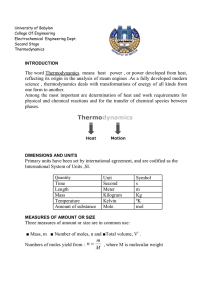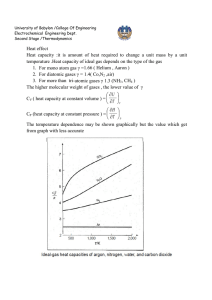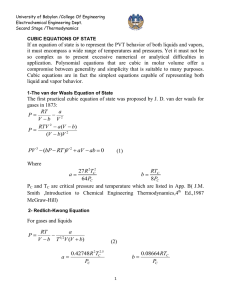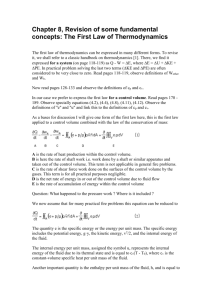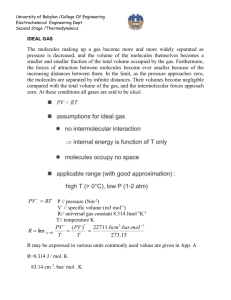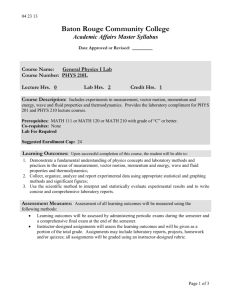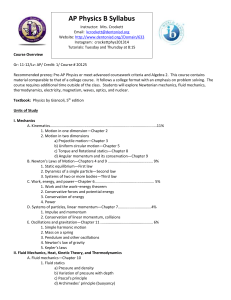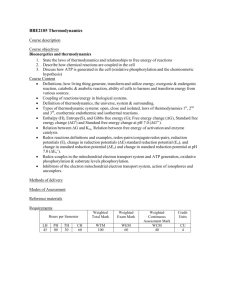pubdoc_2_21447_432
advertisement
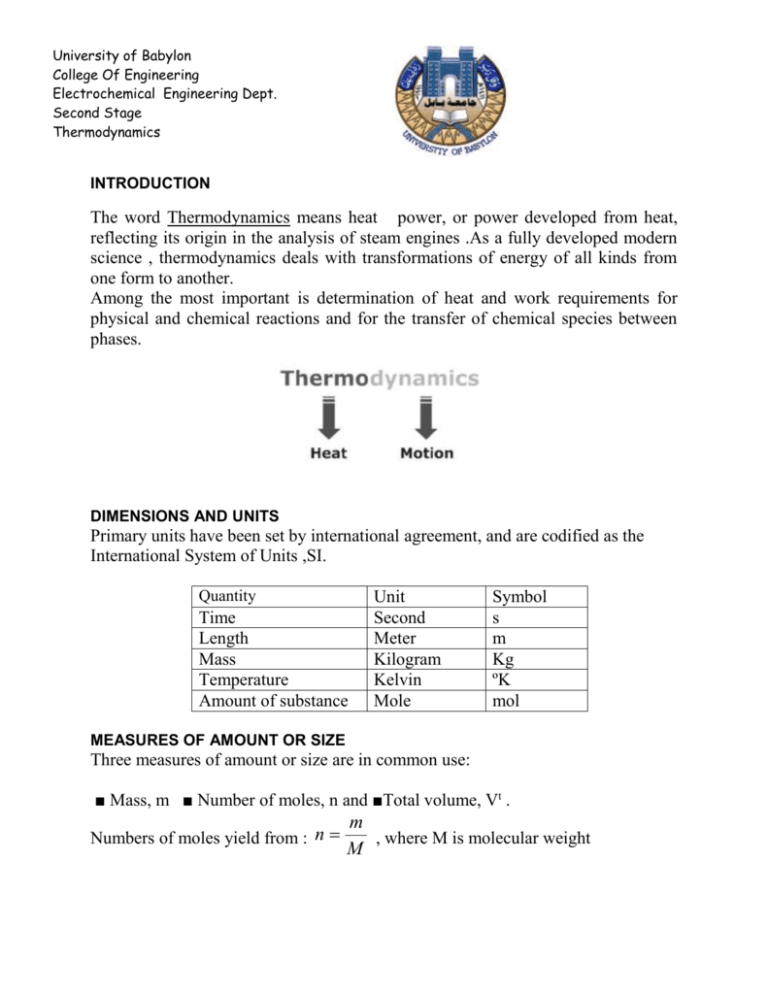
University of Babylon College Of Engineering Electrochemical Engineering Dept. Second Stage Thermodynamics INTRODUCTION The word Thermodynamics means heat power, or power developed from heat, reflecting its origin in the analysis of steam engines .As a fully developed modern science , thermodynamics deals with transformations of energy of all kinds from one form to another. Among the most important is determination of heat and work requirements for physical and chemical reactions and for the transfer of chemical species between phases. DIMENSIONS AND UNITS Primary units have been set by international agreement, and are codified as the International System of Units ,SI. Quantity Time Length Mass Temperature Amount of substance Unit Second Meter Kilogram Kelvin Mole Symbol s m Kg ºK mol MEASURES OF AMOUNT OR SIZE Three measures of amount or size are in common use: ■ Mass, m ■ Number of moles, n and ■Total volume, Vt . Numbers of moles yield from : n m , where M is molecular weight M University of Babylon College Of Engineering Electrochemical Engineering Dept. Second Stage Thermodynamics Total volume, representing the size of a system, is a defined quantity given as the product of three lengths. It may be divided by the mass or number of moles of the system to yield specific or molar volume: Vt Specific volume V m Vt Molar volume V n Specific or molar density is defined as the reciprocal of specific or molar volume: p = V-1.These quantities (V and p) are independent of the size of a system, and are examples of intensive thermodynamic variables. They are functions of the temperature, pressure, and composition of a system, additional quantities that are independent of system size. Force The force unit is Newton , symbol ,N ,The Newton is defined as the force which when applied to a mass of 1 kg produces an acceleration of 1 m s -2 ; thus the Newton is a derived unit representing 1 kg m s-2 F=ma The kilogram force is equivalent to 9.806 65 N. ( 1 Newton = Kg .m . s-1) In the metric engineering system of units, force is treated as an additional independent dimension along with length, time, and mass . The kilogram force(kg f ) is defined as that force which accelerates 1 kilogram mass 9.806 65 meters per second per second . F 1 ma gc where 1Kg f 1 1Kg 9.8m.s 1 gc And gc =9080665 Kg.m.Kg f -1s-2 University of Babylon College Of Engineering Electrochemical Engineering Dept. Second Stage Thermodynamics Weight properly refers to the force of gravity on a body, and is therefore correctly expressed in Newton’s or in kilograms force. Temperature Temperature is degree of hotness ,and it is commonly measured with liquid-inglass thermometers, wherein the liquid expands when heated. Thus a uniform tube, partially filled with mercury, alcohol, or some other fluid, can indicate degree of "hotness" simply by the length of the fluid column. However, numerical values are assigned to the various degrees of hotness by arbitrary definition. t C T K 273.15 t F T R 459.67 T R 1.8T K University of Babylon College Of Engineering Electrochemical Engineering Dept. Second Stage Thermodynamics PRESSURE The pressure P exerted by a fluid on a surface is defined as the normal force exerted by the fluid per unit area of the surface. The unit used is called Pascal , symbol Pa (N.m-2) . In the metric engineering system a common unit is the kilogram force per square centimeter (kgf cm-2 ). The primary standard for pressure measurement is the dead-weight gauge in which a known force is balanced by a fluid pressure acting on a known area P F mg A A Where m is mass , g local acceleration , and A is the cross sectional area . Gauges in common use, such as Bourdon gauges, are calibrated by comparison with deadweight gauges. Since a vertical column of a given fluid under the influence of gravity exerts a pressure at its base in direct proportion to its height This is the basis for the use of manometers for pressure measurement. Conversion of height to force per unit area follows from Newton's law applied to the force of gravity acting on the mass of fluid in the column. The mass is given by: P F mg Ahg gh A A A The pressure to which a fluid height corresponds is determined by the density of the fluid (which depends on its identity and temperature) and the local acceleration of gravity. Thus the (torr) is the pressure equivalent of 1 millimeter of mercury at 273.15 K (0°C) in a standard gravitational field, and is equal to 133.322 Pa. Another unit of pressure is the standard atmosphere (atm), the approximate average pressure exerted by the earth's atmosphere at sea level, defined as 101 325 Pa, 101.325 kPa, or 0.101 325 MPa. The bar, an SI unit defined as l05 Pa, is equal to 0.986 923 atm. Most pressure gauges give readings which are the difference between the pressure of interest and the pressure of the surrounding atmosphere. These readings are known as gauge pressures, and can be converted to absolute pressures by addition of the barometric pressure. Absolute pressures must be used in thermodynamic calculations. University of Babylon College Of Engineering Electrochemical Engineering Dept. Second Stage Thermodynamics WORK Work W is performed whenever a force acts through a distance. By definition, the quantity of work is given by the equation: dW Fdl where F is the component of force acting along the line of the displacement dl. The work which accompanies a change in volume of a fluid is often encountered in thermodynamics University of Babylon College Of Engineering Electrochemical Engineering Dept. Second Stage Thermodynamics dW pAd V A dW pdV since A is constant V2 dW PdV V1 The minus sign is required because the volume change is negative. The above equation expresses the work done by a finite compression or expansion process. Figure below shows a path for compression of a gas from point 1 with initial volume V1 at pressure P1 to point 2 with volume V2 at pressure P2. This path relates the pressure at any point of the process to the volume. The work required is given by equation and is proportional to the area under the curve of Fig. The SI unit of work is the newton-meter or joule, symbol J. In the metric engineering system the unit often used is the meter-kilogram force (m kgf).
